Yes, in a shed or during the summer months.
During winter it is not advisable to let your cat live in a shed unless it is very well insulated keep it warm and cosy.
Allowing your cat to live in a shed in your garden can be a good compromise if you have a family member who is allergic to cats, that they need more space to live, or if your cat loves being outdoors and would prefer to live outside.
Would A Cat Like Living in a Shed?
How well your cat will fare living outdoors in a shed is largely down to their individual personalities and habits, as well as their age.
Indoor Cats
If your cat has been a house cat for its entire life, transitioning directly to living in a shed may be too challenging and cause severe stress.
You should start by getting your cat used to the outdoors.
To do this, choose a quiet and dry day and supervise to ensure they get a positive first experience.
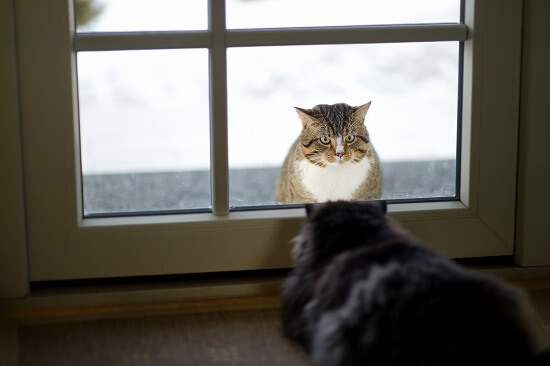
Let your cat explore in their own time and they will gradually get used to the outside world, and eventually, you can let them out on their own.
If your cat responds positively to this and goes outside at every given opportunity, then they will likely enjoy living outdoors in a shed.
If your cat is already a free roamer and loves the outdoors, then great!
They will likely be incredibly happy living outside so that they can explore as and when they wish.
Senior Cats or Kittens
Another consideration when deciding whether to move your cat outside is their age.
As a general rule, kittens and senior cats should never live in a shed.
Kittens need to be under supervision in case they get into any trouble, and they are also much more sensitive to changes in temperature and other factors.
Therefore, keeping kittens alone in a shed could be dangerous.
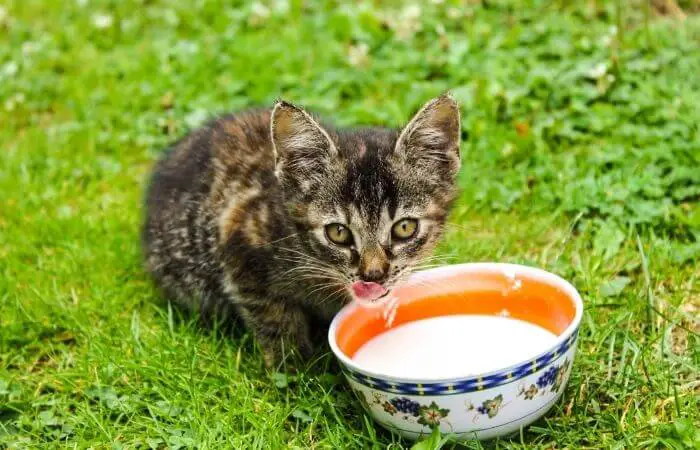
Similarly, elderly cats are not good to move to outside living, especially if they have never lived this like before in their life, as it will be much harder for them to adapt and accept the change.
Also, some elderly cats may have motility of health conditions which means they wouldn’t stand much chance in a fight, and cannot deal with temperature fluctuations as well.
On the other hand, if your cat is healthy and agile, outdoor life may suit them perfectly.
How To Setup a Shed for Cats
While it is safe for cats to live in sheds, there are certain factors when building an outdoor home for your cat that you must consider.
1. Climate Control
If you are building a home for your cat in your shed, it is essential you consider climate control so that as the weather changes, your cat will be comfortable in their new home.
The material your shed is made of is important in ensuring your cat stays warm in its outdoor home, especially in winter, or if you live in a colder country.

A typical wooden shed will work well, or you could convert your garage into a new cat pad.
However, stay clear of greenhouses as these will get too hot in the summer and too cold in the winter, making it difficult for your cat you be comfortable.
You should also think of insulating your shed by using things such as polymer foam, foil insulation, or even bubble wrap if you are on a budget.
Likewise, ensure there are windows that can be opened or some form of ventilation for hotter summer days.
2. Size of the Shed
Purchasing the right size shed can also make a huge difference in how comfortable your cat is when living outdoors.
Although your cat will be living in your garden with the whole of the outside world to roam around in, having a large enough indoor space is still vital for when they wish to sleep, or when the weather is bad.
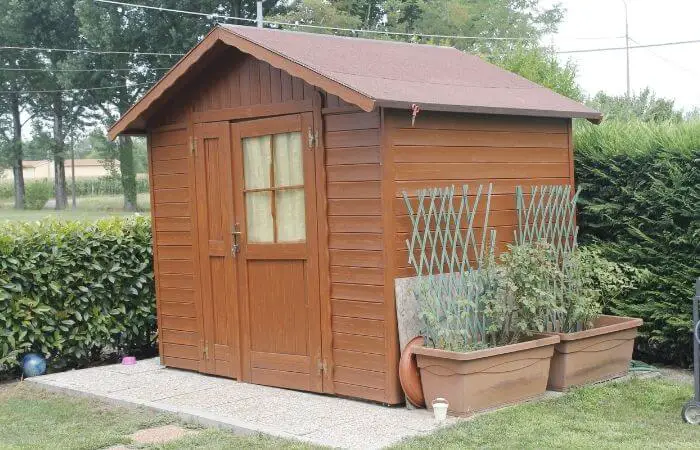
If you have more than one cat, this is an extra-important consideration as cats are naturally solitary creatures and so need to have their own space, even if your cats appear to get along, or they could become highly stressed.
can develop several behavioural issues such as spraying, growling, and acting aggressive, or get unwell and develop feline cystitis.
3. Size of the Entrance
You should also consider the size of the entrance as if not, dogs or other predators could get inside, which could have disastrous consequences.
If you are using a regular garden shed, it likely has a normal door.
Instead of using this as the entry point for your cat, install a so that only cats can get in and out of the shelter.
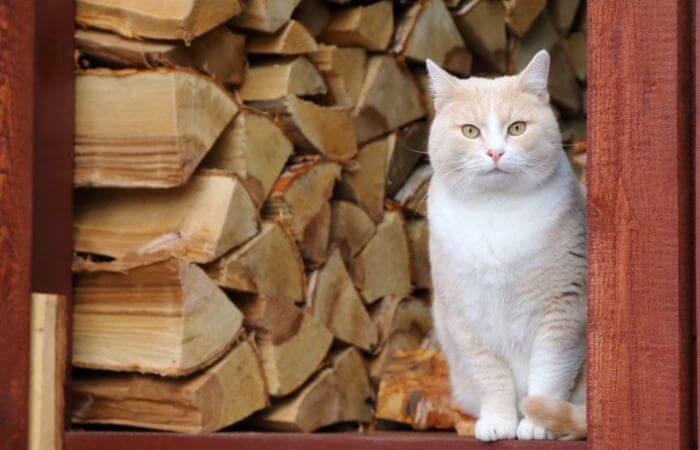
If you are concerned about stray or feral cats taking advantage of your pet’s home, you should consider purchasing a microchip reader or one that has collar control.
This will ensure it is only your cats entering and leaving the shed, which gives them a much nicer and more private home.
For anyone on a budget, you could also cut out cat-sized holes in one of the sides of the shed and line the edges with tape to make them smooth and prevent any injuries.
This is cheaper than purchasing a cat flap for your cat shed.
4. Protect from Bad Weather
It is also a good idea to help protect the entrances of your shed from bad weather to help keep out any rain or snow from making the inside damp.
One idea is to put a ledge on the outside of the shed over the doors and windows which will help keep bad weather away.
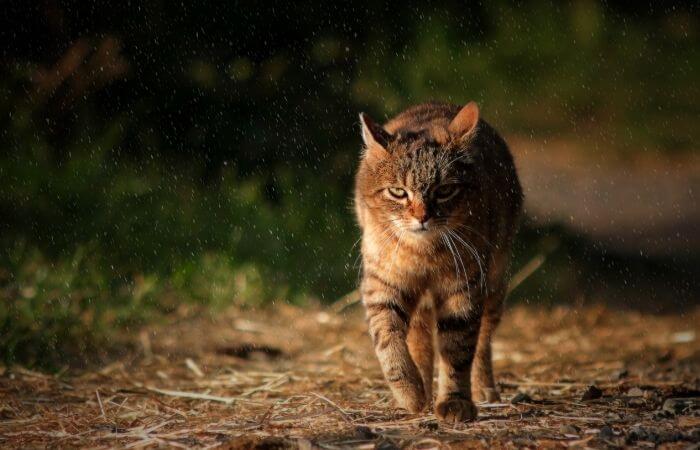
You could also attach some tarpaulin to the shed over the doors and have it stretched out like an awning.
This is the better option if you have space as it provides better protection from bad weather and also gives your cats some space to get some fresh air without getting soaked on rainy days.
5. Internal Furnishings
You cannot leave your cats with an empty shed and must correctly set up the inside to make it somewhere that they will love to be.
On the inside of your cat shed, you should put up shelving.
Cats love being able to climb as this is one of their instinctive behaviours, and so giving them lots of places to climb will keep them happy and entertained.
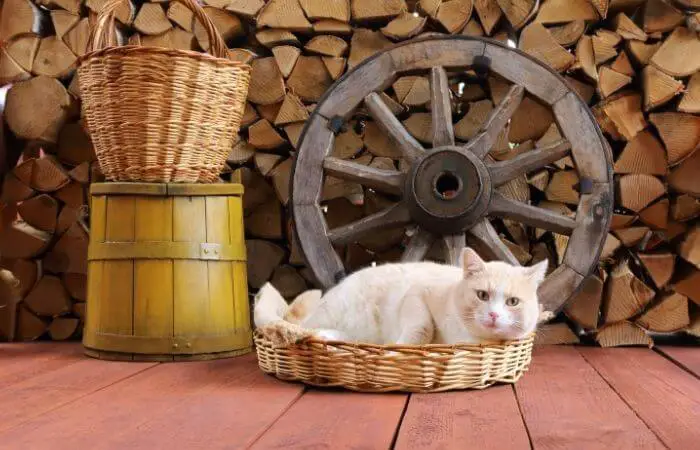
Shelving is also a good place for cats to perch and sleep on, as they love having a private corner up high so that they can survey the room and feel safe.
You should also add comforting items such as blankets, towels, and pet beds so that it is inviting for your cats.
and other places to hide and curl up are also a great idea.
These items will also help your cat to keep warm on colder days and add more insulation than if they just slept on the bare floors.
A feeding and watering station is another nice touch so that your cat has a designated place they can go to for their food.
Be sure to remember to top up their food and water regularly even though the shed is outdoors, or invest in a and an so that your pet is taken care of all day long.
Related article:
Reasons For Cats To Live Outdoors
There are several reasons that owners may consider creating a home for their cat outside in a shed:
Cat Allergies
Some people may not have realised they were before getting one as a pet (Dan, the editor here, has a severe cat dander allergy, I only discovered this in October 2020 despite having had a cat for five years – I now deal with it by hoovering lots!), or others may have had people move in that cannot live with their cat.

Having a cat as an outdoor pet helps deal with allergies and lets owners keep their cats rather than having to send them to a shelter.
Too Many Cats
If your cat has had a litter of kittens that you have ended up keeping, or perhaps you adopted a few too many strays, your home may not be big enough for the number of cats you currently own.
Creating a home outdoors in your shed can provide your cats with more space and more freedom so that they are happy.
Stray or Outdoor Cats
Sometimes, particularly if your cat used to be a stray, they are much happier living outside compared to inside.
If your cat loves being outdoors and spends more time running around outside than or in their favourite hidey-hole, you may look at an outdoor home for them to give them a happier life.
As an Amazon Associate I may earn a small fee from qualifying purchases at no extra cost to you. This helps us run the site, so thanks for your support!
- What Kind Of These People?! No One Stops To Save The Poor Cat Baby!
- Family Takes in Kitten from a Field, 24 Hours Later They End Up with 2 More Cats from an Attic and a Shed
- Finding signs of Puppy that was abandoned in the middle of a harsh winter at a landfill
- A Couple Driving Across The Bridge Noticed a Strange Pair of Eyes on the Side Of The Road!!!
- People Passing By Ignored A Lonely Red Cat Shivering On The Cold Concrete At The Entrance…!

